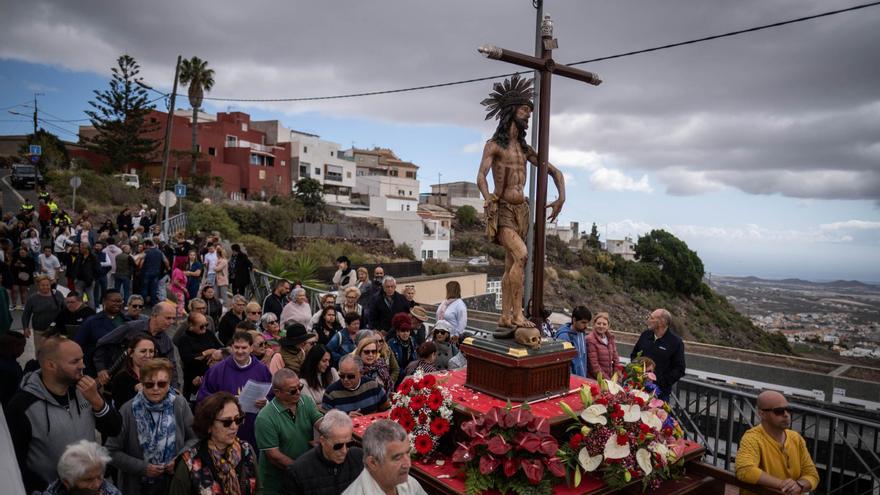
The residents of the municipality of Arona once again resorted this Sunday, as they have been doing for almost a century, to their beloved Cristo de la Salud to ask for rain for a countryside suffering the consequences of a severe drought that three days ago forced the Tenerife Island Council to declare a water emergency.
Coincidentally, or not, this Sunday was a rainy day in much of the Tenerife’s geography. In this southern town, there were also some light showers that, although mild, were welcomed as a true relief after water reserves have plummeted by over 30 percent in the last year in Tenerife. The countryside needs water and once again looks up to the sky, just as it did decades ago, specifically in the twenties of the last century when the traditional Arona petition began to be celebrated.
In Canary Islands, the tradition of petitions is long-standing. Islanders, who for a long time lived off the crops of a fertile but sometimes harsh land, historically resorted to their patron saints and Marian advocations when despair spread among the population.
If it doesn’t rain, there are no harvests, and times of scarcity and hunger even led to almost completely emptying entire islands because their inhabitants, desperate, decided to seek their future in other geographical horizons.
In the Archipelago, great reliance has also been placed on divine powers to address another of its great threats: the fury of eruptions. In Lanzarote, for example, its patron saint, the Virgin of Sorrows, is popularly known as the Virgin of Volcanoes because, according to tradition, she managed to stop the burning lava just a few meters from where her temple stands today. Processions of this kind are also remembered with the arrival of plagues, such as the locust plague of the late 1958, which ravaged crops putting the survival of entire families at risk. The same happened with epidemics and health emergencies.
In Arona, this petition has been held regularly every first Sunday of March since the eighties. Although it has now become an annual custom where faithful and residents also take the opportunity to pray for their health and that of their families, and to remember the deceased, originally it was only held when drought prevented sowing in an area where cereal was a rainfed crop and therefore totally exposed to meteorological rigors.
As the mayor of the municipality, Fátima Lemes, highlighted, this petition is a tradition that combines “faith, culture, and heritage.” The mayor celebrated the participation achieved in this edition, with over 200 residents at each of its stops, and thanked the involvement also shown by the different folk groups that honored the Holy Christ of Health with traditional songs. In total, the route started from the Parish of San Antonio Abad, passed through the municipal cemetery, and went through Domínguez Alfonso Street, Constitution Avenue, La Mejora, Sitio Street, and Llano del Rey Path.
Next to the cemetery, a folk group, accompanied by a dance group, performed traditional songs with verses specially prepared for the occasion. “To the Christ of Health, I sing this traditional song so he takes care of our beloved land,” one sang. “I sing this traditional song from the depths of my soul to the Christ of Health. We come to you in petition, bring us rain and life,” they asked with another.
The stop next to the cemetery also served for all those present to pray for their deceased. The priest Father Arnobio blessed those present and reminded that water is a scarce commodity on the entire planet. “Let us pray to the Christ of Health, also, for our personal health and for that rain that our world so desperately needs, not just our town or region.”
The carving of the Christ of Health was returned to the parish on a truck accompanied by several faithful.
It is worth noting that this is one of the three most venerated Christs in Tenerife. Along with the Cristo de La Laguna and the Cristo de Tacoronte, the Arona image is the subject of great devotion. For this reason, the residents of the area resort to its favours when the lack of rain jeopardizes agriculture in a municipality already very traditionally linked to the countryside. Additionally, the Christ of Health holds the title of perpetual mayor of Arona and is the most revered Christ in the entire south of Tenerife.
The image is a polychrome wood carving from the Baroque period that belongs to the Canarian school and was created by the sculptor from Güímar, Lázaro González de Ocampo. As recorded in the local documentation, it was made during the second half of the 17th century. Originally, this sculpture was located in the Convent of San José de La Orotava but was later acquired by the Parish of San Antonio Abad. It was definitively moved to Arona in 1806 and has since been one of the most cherished images by its residents.
The residents of Arona confirmed their fervor by accompanying their Christ through the streets of the town to, once again, ask for the much-needed rain for the Tenerife countryside.
















